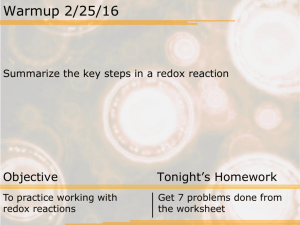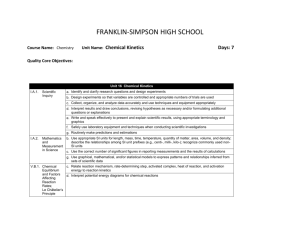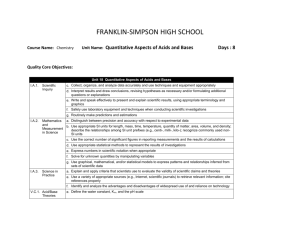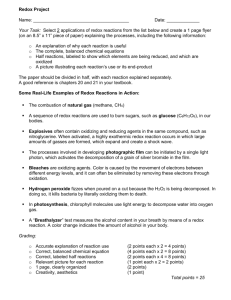19 - Oxidation - Reduction Reactions & Electrochemistry
advertisement
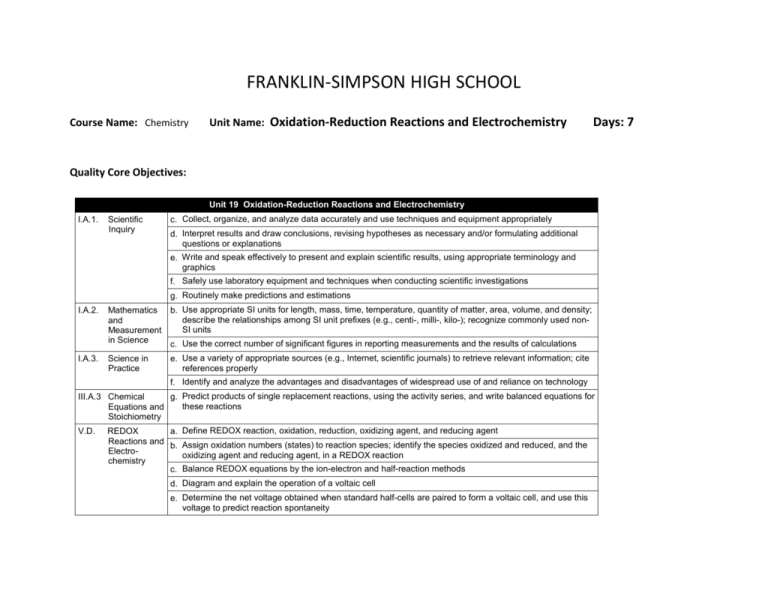
FRANKLIN-SIMPSON HIGH SCHOOL Course Name: Chemistry Unit Name: Oxidation-Reduction Reactions and Electrochemistry Days: 7 Quality Core Objectives: Unit 19 Oxidation-Reduction Reactions and Electrochemistry I.A.1. Scientific Inquiry c. Collect, organize, and analyze data accurately and use techniques and equipment appropriately d. Interpret results and draw conclusions, revising hypotheses as necessary and/or formulating additional questions or explanations e. Write and speak effectively to present and explain scientific results, using appropriate terminology and graphics f. Safely use laboratory equipment and techniques when conducting scientific investigations g. Routinely make predictions and estimations I.A.2. Mathematics b. Use appropriate SI units for length, mass, time, temperature, quantity of matter, area, volume, and density; describe the relationships among SI unit prefixes (e.g., centi-, milli-, kilo-); recognize commonly used nonand SI units Measurement in Science c. Use the correct number of significant figures in reporting measurements and the results of calculations I.A.3. Science in Practice e. Use a variety of appropriate sources (e.g., Internet, scientific journals) to retrieve relevant information; cite references properly f. Identify and analyze the advantages and disadvantages of widespread use of and reliance on technology III.A.3 Chemical g. Predict products of single replacement reactions, using the activity series, and write balanced equations for these reactions Equations and Stoichiometry V.D. REDOX a. Define REDOX reaction, oxidation, reduction, oxidizing agent, and reducing agent Reactions and b. Assign oxidation numbers (states) to reaction species; identify the species oxidized and reduced, and the Electrooxidizing agent and reducing agent, in a REDOX reaction chemistry c. Balance REDOX equations by the ion-electron and half-reaction methods d. Diagram and explain the operation of a voltaic cell e. Determine the net voltage obtained when standard half-cells are paired to form a voltaic cell, and use this voltage to predict reaction spontaneity Purpose of the Unit: Students will be able to identify REDOX reactions, identify the different parts of the reaction, and balance the reaction by various methods. Students will also be able to apply their working knowledge of REDOX reactions to construct voltaic cells, both graphically and experimentally. Students will then be able to predict the available voltage from a cell, as well as its spontaneity. Prerequisites: Students should be able to: Balance equations Predict products of reactions Determine the charge on an ion Daily Lesson Guide Day 1 Lesson Content and Objectives * Predict products of single replacement rxns * Activity series * Balancing equations III.A.3.g Focus Questions * How do you predict the products of a single replacement reaction? * How do I know if the reaction will occur? Critical Thinking (High Yield / Literacy /LTF/etc.) * Summarizing and note taking * Evaluation/ Analysis/ Application * Non-linguistic representation * I Do – We Do – You Do Engagement * Pre-test * ACT bell ringer * Modeled notes * Work sample problems together, alone (formative) Assessment and/or Accommodations * Evaluate pre-test * Evaluate sample problems for understanding Accommodations: prompting/ cueing, paraphrasing, reader, scribe, reduced assignment, extended time (as needed) 2 3-4 5 * REDOX rxns * Oxidation * Reduction * Oxidizing agent * Reducing agent * Oxidation numbers * Balancing REDOX rxns by ion-electron and half-rxn method V.D.a, b, c * Balancing REDOX rxns (cont’d.) * Voltaic cell diagram * Determining net voltage from voltaic cells * Predicting spontaneity V.D.c, d, e * Laboratory: Building a voltaic cell to power a motor I.A.1.c, d, e, f, g I.A.2.b, c I.A.3.e, f III.A.3.g V.D.a, b, c, d, e * What is a REDOX reaction? * What are the parts of a REDOX reaction? * How do I balance a REDOX reaction? * Summarizing * Evaluation/ Analysis * Non-linguistic representation * I Do – We Do – You Do * Identifying similarities and differences * ACT bell ringer * Modeled notes * Work sample problems together, alone (formative) * Evaluate sample problems for understanding Accommodations: prompting/ cueing, paraphrasing, reader, scribe, reduced assignment, extended time (as needed) * How do I balance a REDOX reaction? * How do I represent a voltaic cell and determine the voltage potential? * How do I know if a battery is spontaneous? * How can I apply what I know from this unit build a voltaic cell (battery) and power a motor? * Summarizing and note taking * Analysis/ Application * Non-linguistic representation * Identifying similarities and differences * I Do – We Do – You Do * Advanced organizers * ACT bell ringer * Modeled notes * Work sample problems together, alone (formative) * Article about manufacturing batteries * Evaluate sample problems for understanding * Evaluate comprehension of article Accommodations: prompting/ cueing, paraphrasing, reader, scribe, reduced assignment, extended time (as needed) * Synthesis/ Application/ Analysis * Identifying similarities and differences * Learning with others * Authenticity * Novelty and Variety * Generating and testing hypotheses * ACT bell ringer * Conduct lab according to procedures provided (summative) * Evaluate lab report Accommodations: Partner students based on skill level, prompting/ cueing, extended time (as needed) 6 7 * Review I.A.1.c, d, e, f, g I.A.2.b, c I.A.3.e, f III.A.3.g V.D.a, b, c, d, e * Exam I.A.1.c, d, e, f, g I.A.2.b, c I.A.3.e, f III.A.3.g V.D.a, b, c, d, e * What can I do to be better prepared for the exam? * Use clickers to test students’ knowledge and clarify and misconceptions before the exam with immediate feedback. * ACT bell ringer * Use clickers to review with exam like questions (summative) * Students participate in review Accommodations: prompting/ cueing, extended time, paraphrasing, reader, use of formula sheet (as needed) * Can I demonstrate my knowledge on the exam? * Evaluation * Analysis * Application * Synthesis * ACT bell ringer * Students take exam (summative) * Evaluate exam Accommodations: prompting and cueing, extended time, paraphrasing, reader, limited choices, use of formula sheet (as needed)
